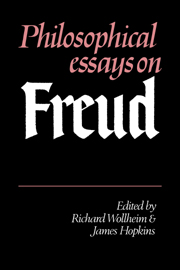Book contents
- Frontmatter
- Contents
- Introduction: philosophy and psychoanalysis
- 1 Conversations on Freud; excerpt from 1932–3 lectures
- 2 Freud, Kepler, and the clinical evidence
- 3 Critical empiricism criticized: the case of Freud
- 4 Freudian commonsense
- 5 Disposition and memory
- 6 On Freud's doctrine of emotions
- 7 The id and the thinking process
- 8 The bodily ego
- 9 Norms and the normal
- 10 On the generation and classification of defence mechanisms
- 11 Models of repression
- 12 Mauvaise foi and the unconscious
- 13 Self-deception and the ‘splitting of the ego’
- 14 Freud's anthropomorphism
- 15 Freud's anatomies of the self
- 16 Motivated irrationality, Freudian theory and cognitive dissonance
- 17 Paradoxes of irrationality
- Works of Freud cited
- Select bibliography
11 - Models of repression
Published online by Cambridge University Press: 01 October 2009
- Frontmatter
- Contents
- Introduction: philosophy and psychoanalysis
- 1 Conversations on Freud; excerpt from 1932–3 lectures
- 2 Freud, Kepler, and the clinical evidence
- 3 Critical empiricism criticized: the case of Freud
- 4 Freudian commonsense
- 5 Disposition and memory
- 6 On Freud's doctrine of emotions
- 7 The id and the thinking process
- 8 The bodily ego
- 9 Norms and the normal
- 10 On the generation and classification of defence mechanisms
- 11 Models of repression
- 12 Mauvaise foi and the unconscious
- 13 Self-deception and the ‘splitting of the ego’
- 14 Freud's anthropomorphism
- 15 Freud's anatomies of the self
- 16 Motivated irrationality, Freudian theory and cognitive dissonance
- 17 Paradoxes of irrationality
- Works of Freud cited
- Select bibliography
Summary
It is beyond any reasonable doubt that there are unconscious mental phenomena of decisive importance for understanding people's lives. But it is not quite so clear in what the unconsciousness of a mental phenomenon consists nor by what processes such a phenomenon is rendered unconscious. In this essay, I wish to direct my attention to these two problems. In particular, I shall focus on three models of unconscious states and repression, a process by which psychic conditions are rendered unconscious. It is important to treat the unconscious and repression simultaneously. For there is a crucial distinction between unconscious and pre-conscious mental states. The essential mark of an unconscious mental state is that one has powerful motives for excluding it from consciousness. After Inhibitions, Symptoms and Anxiety (1926d, XX), it is clear that Freud thought that in some cases of intrapsychic conflict, an unbearable anxiety arises which provides a motive for repression. Repression is thereby represented as an intentional, though nonetheless typically unconscious, mental action (which is not to deny that it might also be a causal process). In modelling repression, then, it is necessary to allow for a psychic phenomenon rendered unconscious, a motive arising from conflict for so rendering it, and means whereby a person can accomplish this aim. This requires characterizing both the state of a mental phenomenon rendered unconscious and means by which a person can render that phenomenon into precisely that state.
- Type
- Chapter
- Information
- Philosophical Essays on Freud , pp. 180 - 202Publisher: Cambridge University PressPrint publication year: 1982
- 25
- Cited by



